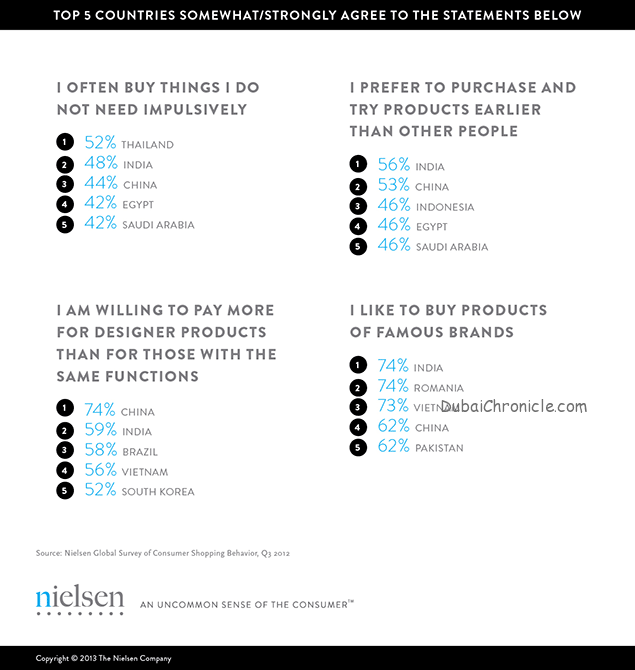
In many growing markets, discretionary income is rising and consumption is expanding beyond the everyday basics. New findings from a Nielsen Global Survey of Consumer Shopping Behavior revealed that many online respondents in Asia-Pacific and Middle-East/Africa are impulse buyers and adopters of new products. Notably, they exceeded the global average of 35 percent for both impulsive spending (AP 40%/MEA 39%) and early adoption (AP 45%/MEA 43%). Countries at the top of the impulse spending and early adoption list included China, India and Indonesia.
Similarly, when it came to brand image, six out of 10 online respondents in Asia-Pacific were willing to pay extra for designer products (61%), exceeding the global average by 17 percentage points. The affinity for buying famous brands was also highest in Asia-Pacific (55%) and Middle East/Africa (56%) markets, notably above the global average of 47 percent. While consumers with Internet access typically skew to a more affluent and younger demographic, these online respondents represent the rising income and upward mobility of developing-market consumers from these regions.
But economic realities prevailed around the world, and overall, there was global alignment on attitudes about the desire for deals and promotions. Price was the most important concern among 65 percent of global respondents. Six out of 10 were aware of promotions and discounts (59%) and believed free gifts were good product incentives (58%). Countries in the developed world topped the list of those with respondents who were most strongly in favor of receiving free gifts.
While more than half of respondents in Latin America (68%), Asia-Pacific (57%) and Middle East/Africa (51%) were especially interested to buy products promoted in the store, only 31 percent of North Americans and 43 percent of Europeans felt the same way.
The findings are based on respondents with online access across 58 countries. While an online survey methodology allows for tremendous scale and global reach, it provides a perspective only on the habits of existing Internet users, not total populations. In developing markets where online penetration has not reached majority potential, audiences may be younger and more affluent than the general population of that country. Additionally, survey responses about purchasing habits are based on claimed behavior, rather than actual metered data.





































